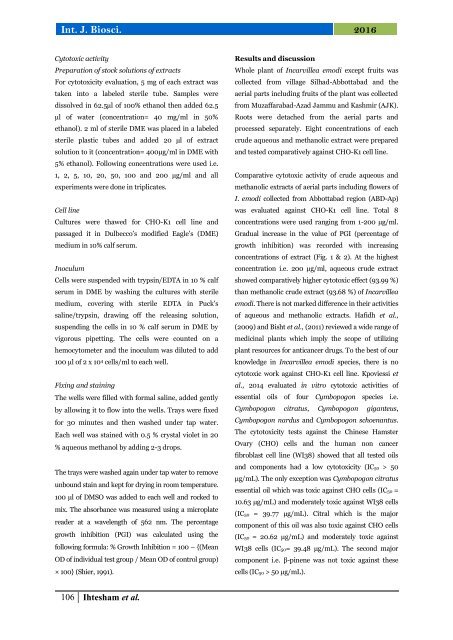Cytotoxic effects of aqueous and methanolic extracts of Incarvillea emodi (Royle Ex Lindl.) Chatterjee on mammalian cells
The present study is designed to investigate the comparative cytotoxic activity of crude aqueous and methanolic extracts of different parts (aerial parts with flowers, roots and aerial parts with fruits) of Incarvillea emodi collected from different Himalayan regions in Pakistan, against CHO-K1 (Chinese hamster ovary cell line). In vitro cytotoxic assay was performed by the crystal violet assay. Cells were suspended with trypsin/EDTA in 10
The present study is designed to investigate the comparative cytotoxic activity of crude aqueous and methanolic extracts of different parts (aerial parts with flowers, roots and aerial parts with fruits) of Incarvillea emodi collected from different Himalayan regions in Pakistan, against CHO-K1 (Chinese hamster ovary cell line). In vitro cytotoxic assay was performed by the crystal violet assay. Cells were suspended with trypsin/EDTA in 10
Create successful ePaper yourself
Turn your PDF publications into a flip-book with our unique Google optimized e-Paper software.
Int. J. Biosci. 2016<br />
<str<strong>on</strong>g>Cytotoxic</str<strong>on</strong>g> activity<br />
Preparati<strong>on</strong> <str<strong>on</strong>g>of</str<strong>on</strong>g> stock soluti<strong>on</strong>s <str<strong>on</strong>g>of</str<strong>on</strong>g> <str<strong>on</strong>g>extracts</str<strong>on</strong>g><br />
For cytotoxicity evaluati<strong>on</strong>, 5 mg <str<strong>on</strong>g>of</str<strong>on</strong>g> each extract was<br />
taken into a labeled sterile tube. Samples were<br />
dissolved in 62.5µl <str<strong>on</strong>g>of</str<strong>on</strong>g> 100% ethanol then added 62.5<br />
µl <str<strong>on</strong>g>of</str<strong>on</strong>g> water (c<strong>on</strong>centrati<strong>on</strong>= 40 mg/ml in 50%<br />
ethanol). 2 ml <str<strong>on</strong>g>of</str<strong>on</strong>g> sterile DME was placed in a labeled<br />
sterile plastic tubes <str<strong>on</strong>g>and</str<strong>on</strong>g> added 20 µl <str<strong>on</strong>g>of</str<strong>on</strong>g> extract<br />
soluti<strong>on</strong> to it (c<strong>on</strong>centrati<strong>on</strong>= 400µg/ml in DME with<br />
5% ethanol). Following c<strong>on</strong>centrati<strong>on</strong>s were used i.e.<br />
1, 2, 5, 10, 20, 50, 100 <str<strong>on</strong>g>and</str<strong>on</strong>g> 200 µg/ml <str<strong>on</strong>g>and</str<strong>on</strong>g> all<br />
experiments were d<strong>on</strong>e in triplicates.<br />
Cell line<br />
Cultures were thawed for CHO-K1 cell line <str<strong>on</strong>g>and</str<strong>on</strong>g><br />
passaged it in Dulbecco’s modified Eagle’s (DME)<br />
medium in 10% calf serum.<br />
Inoculum<br />
Cells were suspended with trypsin/EDTA in 10 % calf<br />
serum in DME by washing the cultures with sterile<br />
medium, covering with sterile EDTA in Puck’s<br />
saline/trypsin, drawing <str<strong>on</strong>g>of</str<strong>on</strong>g>f the releasing soluti<strong>on</strong>,<br />
suspending the <strong>cells</strong> in 10 % calf serum in DME by<br />
vigorous pipetting. The <strong>cells</strong> were counted <strong>on</strong> a<br />
hemocytometer <str<strong>on</strong>g>and</str<strong>on</strong>g> the inoculum was diluted to add<br />
100 µl <str<strong>on</strong>g>of</str<strong>on</strong>g> 2 x 10 4 <strong>cells</strong>/ml to each well.<br />
Fixing <str<strong>on</strong>g>and</str<strong>on</strong>g> staining<br />
The wells were filled with formal saline, added gently<br />
by allowing it to flow into the wells. Trays were fixed<br />
for 30 minutes <str<strong>on</strong>g>and</str<strong>on</strong>g> then washed under tap water.<br />
Each well was stained with 0.5 % crystal violet in 20<br />
% <str<strong>on</strong>g>aqueous</str<strong>on</strong>g> methanol by adding 2-3 drops.<br />
The trays were washed again under tap water to remove<br />
unbound stain <str<strong>on</strong>g>and</str<strong>on</strong>g> kept for drying in room temperature.<br />
100 µl <str<strong>on</strong>g>of</str<strong>on</strong>g> DMSO was added to each well <str<strong>on</strong>g>and</str<strong>on</strong>g> rocked to<br />
mix. The absorbance was measured using a microplate<br />
reader at a wavelength <str<strong>on</strong>g>of</str<strong>on</strong>g> 562 nm. The percentage<br />
growth inhibiti<strong>on</strong> (PGI) was calculated using the<br />
following formula: % Growth Inhibiti<strong>on</strong> = 100 – {(Mean<br />
OD <str<strong>on</strong>g>of</str<strong>on</strong>g> individual test group / Mean OD <str<strong>on</strong>g>of</str<strong>on</strong>g> c<strong>on</strong>trol group)<br />
× 100} (Shier, 1991).<br />
Results <str<strong>on</strong>g>and</str<strong>on</strong>g> discussi<strong>on</strong><br />
Whole plant <str<strong>on</strong>g>of</str<strong>on</strong>g> <str<strong>on</strong>g>Incarvillea</str<strong>on</strong>g> <str<strong>on</strong>g>emodi</str<strong>on</strong>g> except fruits was<br />
collected from village Silhad-Abbottabad <str<strong>on</strong>g>and</str<strong>on</strong>g> the<br />
aerial parts including fruits <str<strong>on</strong>g>of</str<strong>on</strong>g> the plant was collected<br />
from Muzaffarabad-Azad Jammu <str<strong>on</strong>g>and</str<strong>on</strong>g> Kashmir (AJK).<br />
Roots were detached from the aerial parts <str<strong>on</strong>g>and</str<strong>on</strong>g><br />
processed separately. Eight c<strong>on</strong>centrati<strong>on</strong>s <str<strong>on</strong>g>of</str<strong>on</strong>g> each<br />
crude <str<strong>on</strong>g>aqueous</str<strong>on</strong>g> <str<strong>on</strong>g>and</str<strong>on</strong>g> <str<strong>on</strong>g>methanolic</str<strong>on</strong>g> extract were prepared<br />
<str<strong>on</strong>g>and</str<strong>on</strong>g> tested comparatively against CHO-K1 cell line.<br />
Comparative cytotoxic activity <str<strong>on</strong>g>of</str<strong>on</strong>g> crude <str<strong>on</strong>g>aqueous</str<strong>on</strong>g> <str<strong>on</strong>g>and</str<strong>on</strong>g><br />
<str<strong>on</strong>g>methanolic</str<strong>on</strong>g> <str<strong>on</strong>g>extracts</str<strong>on</strong>g> <str<strong>on</strong>g>of</str<strong>on</strong>g> aerial parts including flowers <str<strong>on</strong>g>of</str<strong>on</strong>g><br />
I. <str<strong>on</strong>g>emodi</str<strong>on</strong>g> collected from Abbottabad regi<strong>on</strong> (ABD-Ap)<br />
was evaluated against CHO-K1 cell line. Total 8<br />
c<strong>on</strong>centrati<strong>on</strong>s were used ranging from 1-200 µg/ml.<br />
Gradual increase in the value <str<strong>on</strong>g>of</str<strong>on</strong>g> PGI (percentage <str<strong>on</strong>g>of</str<strong>on</strong>g><br />
growth inhibiti<strong>on</strong>) was recorded with increasing<br />
c<strong>on</strong>centrati<strong>on</strong>s <str<strong>on</strong>g>of</str<strong>on</strong>g> extract (Fig. 1 & 2). At the highest<br />
c<strong>on</strong>centrati<strong>on</strong> i.e. 200 µg/ml, <str<strong>on</strong>g>aqueous</str<strong>on</strong>g> crude extract<br />
showed comparatively higher cytotoxic effect (93.99 %)<br />
than <str<strong>on</strong>g>methanolic</str<strong>on</strong>g> crude extract (93.68 %) <str<strong>on</strong>g>of</str<strong>on</strong>g> <str<strong>on</strong>g>Incarvillea</str<strong>on</strong>g><br />
<str<strong>on</strong>g>emodi</str<strong>on</strong>g>. There is not marked difference in their activities<br />
<str<strong>on</strong>g>of</str<strong>on</strong>g> <str<strong>on</strong>g>aqueous</str<strong>on</strong>g> <str<strong>on</strong>g>and</str<strong>on</strong>g> <str<strong>on</strong>g>methanolic</str<strong>on</strong>g> <str<strong>on</strong>g>extracts</str<strong>on</strong>g>. Hafidh et al.,<br />
(2009) <str<strong>on</strong>g>and</str<strong>on</strong>g> Bisht et al., (2011) reviewed a wide range <str<strong>on</strong>g>of</str<strong>on</strong>g><br />
medicinal plants which imply the scope <str<strong>on</strong>g>of</str<strong>on</strong>g> utilizing<br />
plant resources for anticancer drugs. To the best <str<strong>on</strong>g>of</str<strong>on</strong>g> our<br />
knowledge in <str<strong>on</strong>g>Incarvillea</str<strong>on</strong>g> <str<strong>on</strong>g>emodi</str<strong>on</strong>g> species, there is no<br />
cytotoxic work against CHO-K1 cell line. Kpoviessi et<br />
al., 2014 evaluated in vitro cytotoxic activities <str<strong>on</strong>g>of</str<strong>on</strong>g><br />
essential oils <str<strong>on</strong>g>of</str<strong>on</strong>g> four Cymbopog<strong>on</strong> species i.e.<br />
Cymbopog<strong>on</strong> citratus, Cymbopog<strong>on</strong> giganteus,<br />
Cymbopog<strong>on</strong> nardus <str<strong>on</strong>g>and</str<strong>on</strong>g> Cymbopog<strong>on</strong> schoenantus.<br />
The cytotoxicity tests against the Chinese Hamster<br />
Ovary (CHO) <strong>cells</strong> <str<strong>on</strong>g>and</str<strong>on</strong>g> the human n<strong>on</strong> cancer<br />
fibroblast cell line (WI38) showed that all tested oils<br />
<str<strong>on</strong>g>and</str<strong>on</strong>g> comp<strong>on</strong>ents had a low cytotoxicity (IC50 > 50<br />
μg/mL). The <strong>on</strong>ly excepti<strong>on</strong> was Cymbopog<strong>on</strong> citratus<br />
essential oil which was toxic against CHO <strong>cells</strong> (IC50 =<br />
10.63 μg/mL) <str<strong>on</strong>g>and</str<strong>on</strong>g> moderately toxic against WI38 <strong>cells</strong><br />
(IC50 = 39.77 μg/mL). Citral which is the major<br />
comp<strong>on</strong>ent <str<strong>on</strong>g>of</str<strong>on</strong>g> this oil was also toxic against CHO <strong>cells</strong><br />
(IC50 = 20.62 μg/mL) <str<strong>on</strong>g>and</str<strong>on</strong>g> moderately toxic against<br />
WI38 <strong>cells</strong> (IC50= 39.48 μg/mL). The sec<strong>on</strong>d major<br />
comp<strong>on</strong>ent i.e. β-pinene was not toxic against these<br />
<strong>cells</strong> (IC50 > 50 μg/mL).<br />
106 Ihtesham et al.


















